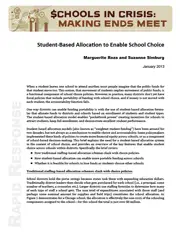Student-based allocation models (also known as weighted student funding) emerged as a more equitable way to distribute funding, create transparency, allow flexibility in resource use, and enable portability with student choice. Student-based allocation puts students at the center of the funding formula by allocating funds to schools on the basis of students and needs, instead of allocating staff or funding programs.
This brief explains the need for a student-based allocation system in the context of school choice and provides an overview of the key features that enable student choice across schools within districts. Specifically, the brief covers:
- How traditional staffing-based allocation schemes clash with choice policies.
- How student-based allocation can enable more portable funding across schools.
- Whether it is feasible for schools to lose funds as students choose other schools.
The brief concludes with a discussion of the kinds of changes schools need to make in order to adapt to shifting enrollments while ensuring that family and student choices enhance school accountability.





